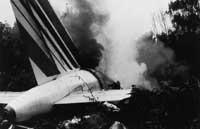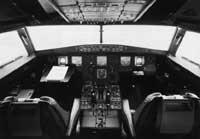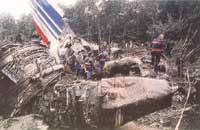Why plane accidents?

The crash of the cargo plane that exploded last October against the houses of Amsterdam was incomprehensible from the aeronautical point of view. It seems that it was caused by a strange mechanical failure. Otherwise you cannot understand. The accident suffered by the A300 Airbus that at the end of last September was descending towards Kathmandu airport was different. Unfortunately it was the most common type of accident.
Whether it is an old or new technology, if the pilot has many years of experience and only a few months, if the plane has or does not have a system that warns that the ground is close, if the airline has or does not have safety prestige, everything seems to not affect this type of accidents. In the catmandú, the pilots drove the plane to the mountains during the maneuver of approach to the airport. Using their language, they were making a “controlled flight to the ground.” In the last decade there have been about 50 accidents such as Kathmandu, which have been the most travelers have killed. According to the air industry, 75% of all accidents are of this type, including that of Oitz in Bizkaia.
These accidents always occur in similar situations: bad weather and with a mountainous and abrupt relief. In addition, sometimes pilots have doubts about the actual position of the plane in the minute before the accident. All the above requirements were met on the A300 Airbus. And that same year, several months earlier, another plane had the same accident in the same place. Also, in January 1991 an A320 Airbus explodes in France against the Vosge under these conditions.

In August 1991 an Air India 737 plane suffered an accident in India as it approached the airport. And in the 80s similar happened in Tenerife and Madrid. Conversations between pilots recorded in the cabins of the crashed planes seem to indicate that the pilots were very nervous, as they were in a potentially dangerous situation. And they knew they were losing control of the plane.
And why? It usually occurs to land the crew after a long and quiet flight. That is, to demonstrate your skill at work, proper procedures are performed and you prepare to land properly. Suppose time and relief hinder this landing procedure. The plane runs through thick clouds and is surrounded by mountains. Suppose the drivers don't know exactly where they are. Then a new element will appear: fear. As if it were a contagious disease, it will spread throughout the cabin and the pilot will take fear.
These conditions, in tune with professional pride, will prevent the choice of a known and adequate solution, that is, ask for help from flight controllers, get out of the bad path and regain all control. On the contrary, the plane will continue in first position, as the pilots, even if they are not sure, expect them to be where they should be. And in most cases it is. But sometimes it is not so. And people die.
According to aircraft manufacturers, the technical level of today's aircraft has grown so much in the last two decades that technical failure accidents have virtually disappeared. Therefore, they say that accidents are due in most cases to pilot failures. Of course, there is always a reason, but today, almost always, there is only one reason: human error, although theoretically the crew has everything necessary to guarantee the total security of the flight. In fact, aircraft that have suffered an accident due to pilot failure were equipped with navigation aids, a flight control computer and the latest alarm system on the nearby terrain.

However, if we analyze this technology in more detail, it is soon detected that not everything is so perfect, so round. For example, nearby ground alarm systems, called GPWS (Ground Proximity Warning Systems), have been deployed in most modern passenger aircraft since the last 15 years. But these systems are useless if the pilot, not realizing it, heads towards a mountain, as they are designed to warn that the ground is near the plane and not in front.
The essence of the system is that the tool is oriented downwards and emits a fixed frequency pulse. The signal, reflected on the ground, returns to the plane. The system calculates the altitude relative to the ground of the plane taking the time elapsed since the signal is sent until the reflected signal arrives. It is usually adjusted to warn when the plane is 50 m from the ground. Then, an ugly metal robot voice that tells the pilot to “go up” or “stand by.” But it often emits false alarms. So the angry drivers sometimes disconnect the system.
Aircraft manufacturers try to design the bow alarm system. But this system should meet two harsh conditions. First, you should detect objects located hundreds of meters from the front end of the plane. That is, it should have a much larger scope than GPWS, since the planes go down to 450 km/h and the pilots, to change gear, take a few seconds. Secondly, the protection system should cover not only in the direction of the longitudinal axis of the plane, but throughout the pre-flight semihemisphere, to protect the plane that goes down and rotates simultaneously.
For both reasons, the development of such an alarm system would cost billions and would be much more expensive than the current simple GPWS system. On the other hand, the installation of radar on the plane is not a solution, since in areas of sheer relief, where it is most needed, would give many false alarms. Some planes already have weather radar, but only serve to detect signals reflected in raindrops, that is, they do not detect solid objects.

The cutting-edge hunting pieces have a radar that separates and classifies the abrupt relief, but their cost is enormous (worth millions of dollars) and the aeronautical industry does not think it deserves this expense, since the crew of commercial aircraft should use it very rarely (almost never).
US companies Honeywell and Bendix have designed an alarm system that is mandatory in the US since 1989 to prevent the collision between two aircraft. The system needs an answering machine on each plane that knows the signal sent from another plane and sends the answer. And, of course, the mountains have no answering machine.
Therefore, the best security system of the aircraft must be the pilot himself. And so it is almost always. Pilots are prepared and learned to act in the worst situations and have often demonstrated their ability in situations that can hardly be believed. The cockpit is a place of great discipline in which pilots and co-drivers have clearly defined their functions. The pilot drives the plane and the co-pilot takes care of the relations and communications with the air traffic controllers, introduces the navigation data into the flight management computer and observes the measuring devices.
The data is read aloud to ensure that all maneuvers are performed correctly and under normal conditions the pilot and co-pilot are controlled with each other. The “normal conditions” are most of the millions of commercial flights that take place each year. But it seems, and it is becoming clearer and clearer, and also better prepared human beings (although they act in a known environment), sometimes they lose orientation and act below the necessary level. This can happen to anyone, but if you are a plane pilot, the consequence may be that many people die. Therefore, the interest in knowing the behavior of the human being is increasing. In the 1960s, after several accidents due to the pilot's failure, investigations into the pilot's behavior proliferated intensively.

The error of action is one of the potential causes of accidents. To combat this, research was carried out on the human factor, techniques were renewed and ergonomic cabins were designed. Numerous improvements have been made in recent years. However, problem detection is usually easier than resolution. Sometimes accidents are due to lack of communication between pilots, since most of the pilots were former military. In the 1960s there was a significant case in a Trident plane. The co-driver saw that the pilot had a moment of uncertainty and had to make a dangerous maneuver, but dared not say anything to the pilot, that there was fear of insubordination and losing the job. The plane fell into a reservoir.
The improvement in crew training has virtually eliminated such problems. There has been an advance in the communication of risk situations, since if the crew detects failures, regardless of who they are, it communicates anonymously to the airline, which has received training aimed at it.
Simulators have also made great strides. Current flight simulators can simulate any situation. It is believed that thanks to them many accidents have been avoided, saving the lives of thousands of people.
The European Industrial Association Airbus and the Boeing Corporation of the USA are making special efforts to know the behavior of pilots in the cabin and reduce the probability of failures in the next generations of pilots. But this field of work is relatively new and it is not known, it cannot be ensured that the percentage of pilot errors is reduced. For example, in 1988 the new A320 Airbus aircraft was launched, which included computer-aided and controlled flight systems and a new ergonomic cabin. He has suffered three accidents in his short life of four years, caused by pilot errors. That is, the best plane can have the same accident.
But the most worrying thing is the continuous and rapid increase in air traffic. The sky is very wide, but it is filling with flying gadgets and forecasts indicate that, despite the economic crisis, air traffic will double in the next ten years. This will cause profound changes throughout the air transport system and a stress on pilots and air controllers. In general, the air transport system is (or will be) prepared to cope with the increase in traffic volume, but statistics indicate that the system will not be prepared to avoid accidents such as Kathmandu. It seems that we are already reaching the minimum number of essential accidents.

The aim of the coming years, taking into account a higher traffic density, is to keep the current minimum. Knowing these worrying predictions, the question that arises spontaneously is do we still need pilots in an increasingly automated world? In most new aircraft, except for landing maneuvers, if scheduled, the autopilot can drive the entire flight. However, the reasons go unexplained, this is a topic to be very careful and the aircraft manufacturers say nothing about it. However, designers are convinced that the mission of the crew, rather than to drive an airplane, must be to monitor and control automatic driving systems.
This would limit the role of the pilot to being part of a set that integrates the entire air traffic system. The connection between ground control and airplane systems would be made directly by digitizable radio signals. In this way, the information about the behavior of the plane would be sent to land and from here you could directly access the systems that conduct the flight, data and navigation orders. In the meantime, the satellites would constantly monitor the plane and send to the ground control data on its trajectory to compare them with those sent by the plane.
Pilots begin to worry because they believe their profession will be limited to being a well-paid caretaker who oversees the plane's automatic march. But this will not happen tomorrow morning. You have to walk a long way to get there. In the pilot's brain the key to accidents or accidents remains.





